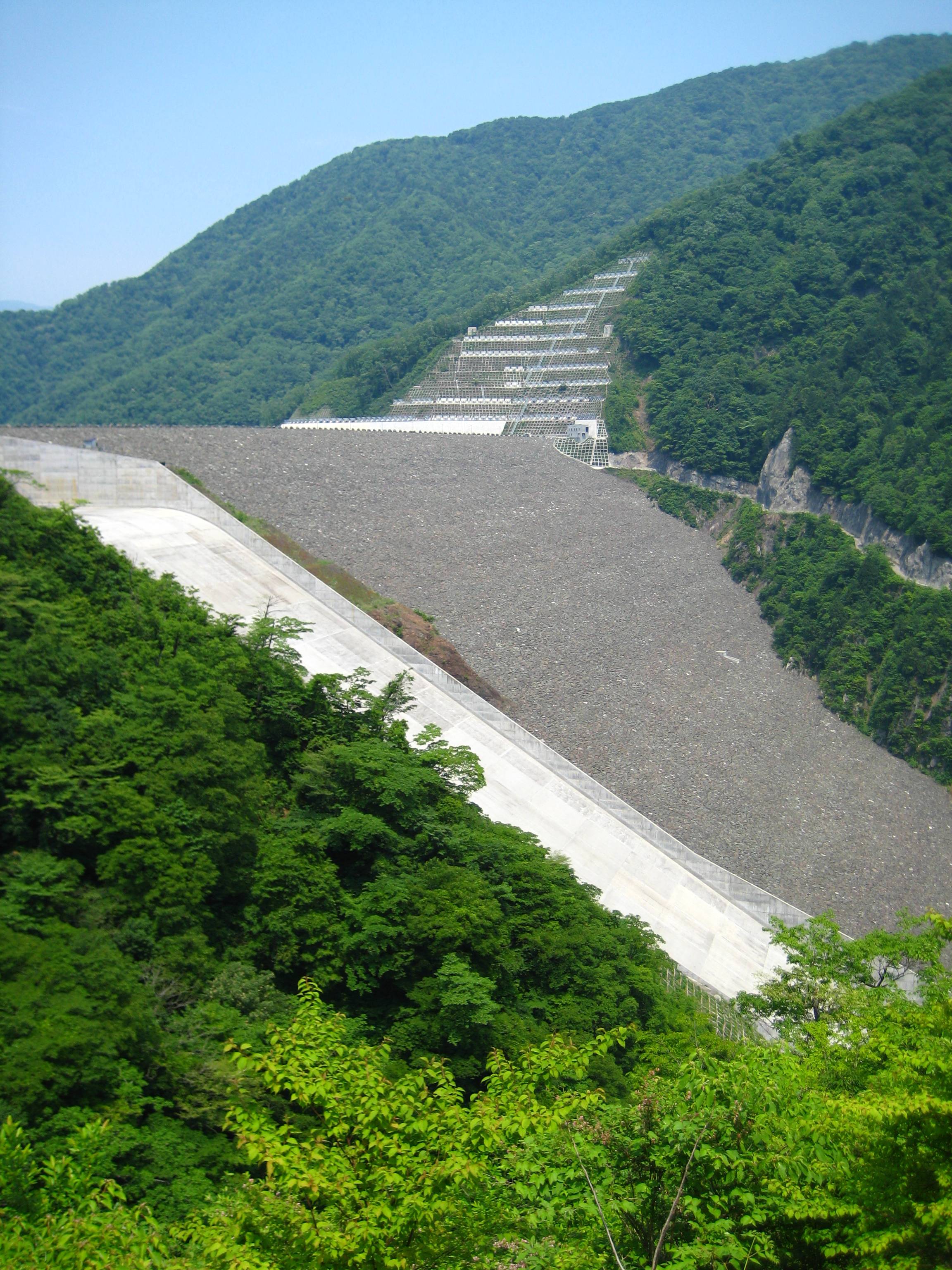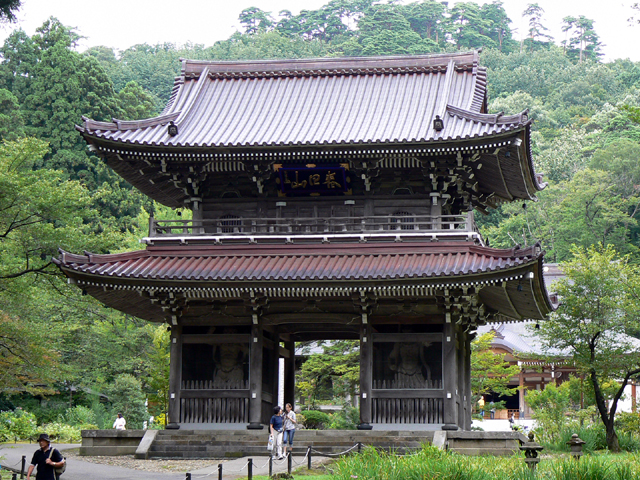|
Futai Dam
is a dam in Yuzawa, Niigata Prefecture, Japan, completed in 1978. is a dam constructed on the Kiyotsu River, Shinano River System, found in Yuzawa, Niigata Prefecture, Japan. The 87-meter high rock-fill dam forms the lower reservoir of J-POWER's (Electric Power Development Co., Ltd.) large-scale pumped-storage hydroelectric power stations Oku-Seizu and Oku-Seizu No. 2. Water is continually transferred between the upper reservoir and Kassa dam (Lake Tashiro) and the lower reservoir, providing up to 1600 megawatts of electricity. History As Japan's longest river, after passing Nagano Prefecture, Shinano River converges with many tributaries as it flows through Niigata Prefecture. After the Second World War, the newly formed J-POWER began work on developing hydroelectric power projects on the Kiyotsu river system. The mountainous region houses many hydroelectric power stations due to its heavy snowfall and its abundance of rapids owing to its topology. In the 1960s, J-POWER ... [...More Info...] [...Related Items...] OR: [Wikipedia] [Google] [Baidu] |
Yuzawa, Niigata
is a Towns of Japan, town located in Niigata Prefecture, Japan. , the town had an estimated population of 7,926, and a population density of 22.2 persons per km2. The total area of the town was . The town is famous for its onsen, hot springs. Geography Yuzawa is located in southwestern Niigata Prefecture, in a mountainous area bordering northern Nagano Prefecture and northern Gunma Prefecture. Due to its geographical location between the Sea of Japan and the surrounding Japanese Alps it has one of the highest annual snowfalls in Japan. There are numerous ski resorts within the region. Mount Naeba (2143 meters) is partly located within the town limits. Much of the town is within the borders of either the Jōshin'etsu-kōgen National Park or the Uonuma Renpo Prefectural Park. Surrounding municipalities *Niigata Prefecture **Minamiuonuma, Niigata, Minamiuonuma **Tōkamachi, Niigata, Tōkamachi **Tsunan, Niigata, Tsunan *Nagano Prefecture **Sakae, Nagano, Sakae *Gunma Prefecture * ... [...More Info...] [...Related Items...] OR: [Wikipedia] [Google] [Baidu] |
Electrical Device
Electric(al) devices are devices that functionally rely on electric energy ( AC or DC) to drive their core parts (electric motors, transformers, lighting, rechargeable batteries, control electronics). They can be contrasted with traditional mechanical devices which depend on different power sources like fuels or human physical strength. Electronic devices are a specialized kind of electrical devices in which electric power is predominantly used for data processing rather than the generation of mechanical forces. To better differentiate between both classes, electric devices that emphasize physical work are also called electromechanical. Mechatronics accentuates the intersection of both fields. Together, electronic and electric devices, their development, maintenance, and power supply comprise the subject of electrical engineering. The majority of electric devices in households is stationary and — due to their considerable power consumption — relies on electrical inst ... [...More Info...] [...Related Items...] OR: [Wikipedia] [Google] [Baidu] |
Dams In Niigata Prefecture
A dam is a barrier that stops or restricts the flow of surface water or underground streams. Reservoirs created by dams not only suppress floods but also provide water for activities such as irrigation, human consumption, industrial use, aquaculture, and navigability. Hydropower is often used in conjunction with dams to generate electricity. A dam can also be used to collect or store water which can be evenly distributed between locations. Dams generally serve the primary purpose of retaining water, while other structures such as floodgates or levees (also known as dikes) are used to manage or prevent water flow into specific land regions. The earliest known dam is the Jawa Dam in Jordan, dating to 3,000 BC. The word ''dam'' can be traced back to Middle English, and before that, from Middle Dutch, as seen in the names of many old cities, such as Amsterdam and Rotterdam. History Ancient dams Early dam building took place in Mesopotamia and the Middle East. Dams were used ... [...More Info...] [...Related Items...] OR: [Wikipedia] [Google] [Baidu] |
List Of Dams And Reservoirs In Japan
As a nation of islands and narrow, steep valleys, dams play a vital role in Japanese society as they are constructed primarily to control floods, supply water and generate hydroelectric power. The tallest dam in Japan is the high Kurobe Dam. The largest dam by structural volume in the country is the Tokuyama Dam ''(pictured)'' with of rock-fill. Tokuyama also creates Japan's largest reservoir with a water volume of . The dams are arranged by prefecture in the list below. Chubu region * Aichi * Fukui * Gifu * Ishikawa * Nagano * Niigata * Shizuoka * Toyama * Yamanashi Chugoku region * Hiroshima * Okayama * Shimane * Tottori * Yamaguchi Kansai region * Hyogo * Kyoto * Mie * Nara * Osaka * Shiga * Wakayama Kanto region * Chiba * Gunma * Ibaraki * Kanagawa * Saitama * Tochigi * Tokyo Kyushu region * Fukuoka * Kagoshima * Kumamoto * Miyazaki * Nagasaki * Okinawa * Oita * Saga Hokkaido region * Hokkaido Shikoku region * Ehime * Kagawa * Kochi * Tokushima Tohoku re ... [...More Info...] [...Related Items...] OR: [Wikipedia] [Google] [Baidu] |
Jōshin'etsu-kōgen National Park
is a national park in the Chūbu region of the main island of Honshū, Japan formed around several active and dormant volcanoes. It spans the mountainous areas of Gunma, Nagano, and Niigata prefectures. The name refers to the two mountain ranges that make up the park. It was divided into two separate areas: the Southern Niigata/North Nagano Area and the East Nagano Area. History Jōshin'etsu-kōgen National Park was established in 1949 and significantly expanded in 1956 to include the Myōkō-Togakushi mountainous region. The latter was separated as Myōkō-Togakushi Renzan National Park on March 27, 2015 with 39.772 ha. Etymology The name of the park consists of two elements. The first, "Jōshin'etsu", is a kanji acronym consisting of three characters which represent the former names of provinces of the area: in present-day Gunma Prefecture, in present-day Nagano Prefecture, and in present-day Niigata Prefecture. The second, "kōgen", means tableland or plateau. Southwes ... [...More Info...] [...Related Items...] OR: [Wikipedia] [Google] [Baidu] |
Monuments Of Japan
is a collective term used by the Japanese government's Law for the Protection of Cultural Properties to denote Cultural Properties of JapanIn this article, capitals indicate an official designation as opposed to a simple definition, e.g "Cultural Properties" as opposed to "cultural properties". as historic locations such as shell mounds, ancient tombs, sites of palaces, sites of forts or castles, monumental dwelling houses and other sites of high historical or scientific value; gardens, bridges, gorges, mountains, and other places of great scenic beauty; and natural features such as animals, plants, and geological or mineral formations of high scientific value. Designated monuments of Japan The government ''designates'' (as opposed to '' registers'') "significant" items of this kind as Cultural Properties (文化財 ''bunkazai'') and classifies them in one of three categories: * * , * . Items of particularly high significance may receive a higher classification as: * * * ... [...More Info...] [...Related Items...] OR: [Wikipedia] [Google] [Baidu] |
Cultural Properties Of Japan
A is administered by the Government of Japan, Japanese government's Agency for Cultural Affairs (Ministry of Education, Culture, Sports, Science and Technology), and includes Tangible Cultural Properties of Japan, tangible properties (structures and works of art or craft); Intangible Cultural Properties of Japan, intangible properties (performing arts and craft techniques); Mingei, folk properties both tangible and intangible; Monuments of Japan, monuments historic, scenic and natural; Cultural Landscapes of Japan, cultural landscapes; and Groups of Traditional Buildings, groups of traditional buildings. Cultural Properties of Japan#Buried Cultural Properties, Buried properties and Conservation Techniques for Cultural Properties, conservation techniques are also protected. Together these cultural properties are to be preserved and utilized as the heritage of the Japanese people. Not all Cultural Properties of Japan were created in Japan; some are from China, Korea or other countri ... [...More Info...] [...Related Items...] OR: [Wikipedia] [Google] [Baidu] |
Kiyotsu Gorge
is a nationally designated Place of Scenic Beauty and Natural Monument on the border Yuzawa and Tōkamachi, Niigata Prefecture, Japan. Kiyotsu-kyō is a canyon located on the Kiyotsu River with a total length is 12.5 kilometers within the Jōshin'etsu-kōgen National Park. The canyon is regarded as one of the three major canyons in Japan, along with the Kurobe Gorge and the Osugidani Gorge. A hot spring A hot spring, hydrothermal spring, or geothermal spring is a spring produced by the emergence of geothermally heated groundwater onto the surface of the Earth. The groundwater is heated either by shallow bodies of magma (molten rock) or by circ ... resort, the Kiyotsukyō Onsen, is located at the entry to the gorge and attracts a large number of visitors especially during autumn foliage season. There is a pedestrian tunnel with a total length of 750 meters along the wall of the gorge for sightseers. Formerly, there was a climbing path along the side of the river, but it w ... [...More Info...] [...Related Items...] OR: [Wikipedia] [Google] [Baidu] |
Naeba Ski Resort
is a ski resort on the eastern slope of in , Niigata Prefecture. This ski resort was formerly run by Kokudo, and currently is run by Prince Hotel, which merged with Kokudo in 2006. Naeba is one of the most popular ski resorts in Japan due to its accessible location from Tokyo and relatively long snow season with snow making machines. On the bottom, Naeba Prince Hotel, which has 1,299 rooms, 20 restaurants, convenience stores, and other facilities, serves skiers. On top of the hotel, skiers can choose their accommodations from various types of hotels and ryokans, some of which has hot spring baths, in nearby Asagai town. Naeba Ski Resort composes Mt. Naeba Ski Resort with Kagura Ski Areas by combining both areas with Doragondola. On the opposite mountain across Asagai town, a small Asagai Area accommodates mainly family skiers. The resort is 40 minutes from Echigo-Yuzawa Station on the Joetsu Shinkansen by non-stop express bus. This station is approximately from Tokyo. Ski ... [...More Info...] [...Related Items...] OR: [Wikipedia] [Google] [Baidu] |
Niigata Prefecture
is a Prefectures of Japan, prefecture in the Chūbu region of Honshu of Japan. Niigata Prefecture has a population of 2,227,496 (1 July 2019) and is the List of Japanese prefectures by area, fifth-largest prefecture of Japan by geographic area at . Niigata Prefecture borders Toyama Prefecture and Nagano Prefecture to the southwest, Gunma Prefecture to the south, Fukushima Prefecture to the east, and Yamagata Prefecture to the northeast. Niigata, Niigata, Niigata is the capital and largest city of Niigata Prefecture, with other major cities including Nagaoka, Niigata, Nagaoka, Jōetsu, Niigata, Jōetsu, and Sanjō, Niigata, Sanjō. Niigata Prefecture contains the Niigata Major Metropolitan Area centered on Niigata with a population of 1,395,612, the largest metropolitan area on the Sea of Japan coast and the twelfth-largest in Japan. Niigata Prefecture is part of the historic Hokuriku region and features Sado, Niigata, Sado Island, the sixth largest island of Japan in area follo ... [...More Info...] [...Related Items...] OR: [Wikipedia] [Google] [Baidu] |






